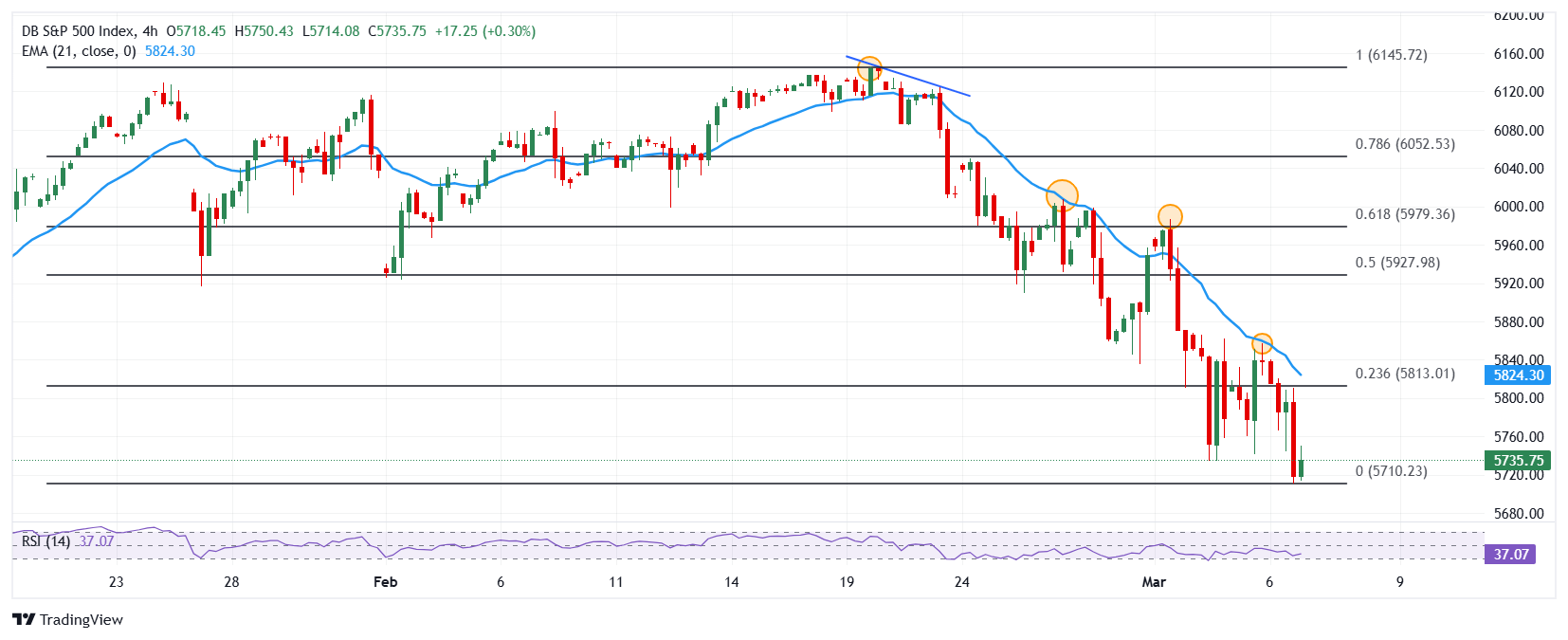- The S&P 500 share index falls 1.75% in the day, currently operating over 5.735.
- Donald Trump changes his tariff posture again, removing tariffs for a month, on any product from Mexico contemplated in the T-MEC.
- The actions of Palantir Technologies (PLT) lose 10.73% today, reaching minimum of two days at 80.01 $.
- The weekly applications of unemployment subsidy fall to 221,000 in the week that ended on February 28, improving the forecasts of analysts.
The S&P 500 registered a maximum of the day in 5,840, attracting aggressive vendors that dragged the index to a minimum of four days in 5,711. At the time of writing, the S&P 500 quotes about 5,735 losing 1.75% on Thursday.
The confusion invades the markets after the tariff delay to Mexico
In the midst of a little defined commercial position, the president of the United States, Donald Trump, has announced that Mexico is exempt from paying tariffs for a month on any article contemplated within the commercial treaty between Mexico, the United States and Canada (T-MEC).
The tariff negotiations between the president of Mexico, Claudia Sheinbaum and her counterpart, Donald Trump, have been subjected to monthly evaluations, in which the president of the United States has highlighted the relationship of both countries in stopping the flow of immigrants and the fight against narcotics.
However, commercial uncertainty confuses financial markets, reflected in the drop of 1.75% in S&P 500 today, reaching a minimum of four months not seen since November 4, 2024.
In this context, the actions of Palantir Technologies (PLTR) lose 10.73% on Thursday, visiting minimums of two days at $ 80.01, thus ending with two consecutive sessions with profits.
On the other hand, the weekly unemployment subsidy requests fell to 221,000 in the week that ended on February 28, below the estimated 235,000 and the 242,000 registered the previous week.
Levels to be considered in the S&P 500
The S&P 500 reacted down from a short -term resistance given by the maximum of March 5 in 5,857. The next resistance zone is observed in 6,007, maximum of February 26. Downwards, the important support is found in 5,672 pivot point of October 2, 2024.
4 -hour graph of the S&P 500

S&P 500 FAQS
The S&P 500 is a very often stock index that measures the yield of 500 public companies and is considered a wide measure of the US stock market. The influence of each company on the calculation of the index is weighted based on stock capitalization. This is calculated by multiplying the number of bought shares of the company for the price of the action. The S&P 500 index has achieved impressive yields: 1.00 $ invested in 1970 would have produced a yield of almost $ 192.00 in 2022. The average annual profitability since its creation in 1957 has been 11.9%.
Companies are selected by Committee, unlike other indices that are included based on established standards. Even so, they must fulfill certain eligibility criteria, the most important of which is stock market, which must be equal to or greater than 12.7 billion dollars. Other criteria are liquidity, domicile, stock capitalization, sector, financial viability, quotation time and representation of the sectors of the United States economy. The nine largest companies in the index represent 27.8% of the stock market capitalization.
There are several ways to operate with the S&P 500. Most of the Stred Betting retail runners and platforms allow operators to use contracts per difference (CFD) to make bets on the price direction. In addition, indexed funds, investment funds and quoted funds (ETF) that follow the price of the S&P 500 can be purchased. The most ETF liquid is the ETF of the London Stock Exchange. The most ETF liquid is the State Street Corporation Spy. The Chicago Mercantile Exchange (CME) offers futures contracts on the index and the Chicago Board of Options (CMOE) offers options, as well as ETF, ETF Inverse and ETF leverage.
There are many factors that promote S&P 500, but mainly it is the aggregate performance of the companies that compose it, revealed in their reports of quarterly and annual results. American and world macroeconomic data also contribute, since they influence investors’ confidence, which is positive drives profits. The level of interest rates, set by the Federal Reserve (FED), also influences the S&P 500, since it affects the cost of credit, which is largely depending on many companies. Therefore, inflation can be a determining factor, as well as other parameters that influence the decisions of the Federal Reserve.
Source: Fx Street
I am Joshua Winder, a senior-level journalist and editor at World Stock Market. I specialize in covering news related to the stock market and economic trends. With more than 8 years of experience in this field, I have become an expert in financial reporting.







